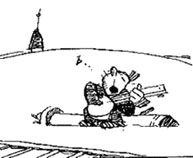
Numerical Methods & Linear Algebra
Math 2890-003
Fall 2016
Chapter 6 — Due Oct 25
- (1 point) Let \[u=\left(\begin{array}{r} -1 \\ -3 \\ -5 \\ 0 \end{array}\right)\quad\text{and}\quad v = \left(\begin{array}{r} 7 \\ -3 \\ -4 \\ -1 \end{array}\right)\]. Find the inner product $u \cdot v$. Show your work.
- (1 point) Let \[v=\left(\begin{array}{r} -6 \\ -4 \\ -2 \\ 5 \end{array}\right).\] Find a unit vector in the direction of $v$. Show your work.
- (1 point) Let \[u=\left(\begin{array}{r} 6 \\ -5 \\ 5 \end{array}\right)\quad\text{and}\quad v = \left(\begin{array}{r} -1 \\ -2 \\ -4 \end{array}\right).\] Find the distance between $u$ and $v$. Show and explain your computations.
- (1 point) Let \[u_1=\left(\begin{array}{r} 1 \\ -5 \\ 5 \\ -1 \end{array}\right),\quad u_2=\left(\begin{array}{r} 5 \\ -3 \\ -3 \\ 5 \end{array}\right)\quad\text{and}\quad u_3=\left(\begin{array}{r} 7 \\ 7 \\ 5 \\ -3 \end{array}\right).\] Is the set $\{u_1, u_2, u_3 \}$ orthogonal? Why or why not? Show your computations.
- (1 point) Let \[y=\left(\begin{array}{r} 4 \\ 5 \\ -3 \end{array}\right)\] and let $W$ be the span of \[\left(\begin{array}{r} 1 \\ 0 \\ -1 \end{array}\right) \text{ and } \left(\begin{array}{r} 3 \\ 2 \\ -3 \end{array}\right).\] Project $y$ onto $W$. Show and explain your computations.
- (1 point) Let \[y=\left(\begin{array}{r} -9 \\ 6 \\ -2 \end{array}\right)\] and let $W$ be the span of \[\left(\begin{array}{r} 3 \\ 3 \\ 0 \end{array}\right) \text{ and } \left(\begin{array}{r} -1 \\ -5 \\ -8 \end{array}\right).\] Find the point in $W$ that is closest to $y$. Show and explain your computations.
- (1 point) Let \[y=\left(\begin{array}{r} -5 \\ 8 \\ 9 \end{array}\right)\] and let $W$ be the span of \[\left(\begin{array}{r} -1 \\ 2 \\ -1 \end{array}\right) \text{ and } \left(\begin{array}{r} -1 \\ -2 \\ 3 \end{array}\right).\] Write $y$ as a sum of a vector in $W$ and a vector orthogonal to $W$. Show and explain your computations.
- (1 point) Let \[A=\left(\begin{array}{rr} 1 & 1 \\ 2 & 3 \\ 1 & 2 \\ 1 & 2 \\ -1 & -1 \end{array}\right)\quad\text{and}\quad b=\left(\begin{array}{r} 0 \\ 1 \\ 0 \\ 7 \\ 7 \end{array}\right).\] Find the least squares solution to $Ax=b$. Show and explain your computations.
- (1 point)
Let \[A=\left(\begin{array}{rr} 0 & 2 \\ -4 & 2 \\ 4 & -1 \\ 1 & -2 \end{array}\right)\quad\text{and}\quad b=\left(\begin{array}{r} 2 \\ -1 \\ -4 \\ 4 \end{array}\right).\]
Find the least squares error in the least squares solution to $Ax=b$. Show and explain your computations.
Hint: The least squares solution is \[x=\left(\begin{array}{r} -0.5665 \\ -0.7639 \end{array}\right).\] - (1 point) Let \[Q=\left(\begin{array}{rr} \ 0.0781 & -0.0746 \\ 0.7028 & -0.4675 \\ 0.0781 & -0.6864 \\ 0.7028 & 0.5521 \end{array}\right),\ R=\left(\begin{array}{rr} 4 & -3 \\ 0 & 2 \end{array}\right)\ \text{and}\ b=\left(\begin{array}{r} 0 \\ 4 \\ -1 \\ -3 \end{array}\right).\] Use the QR factorization $A=QR$ to find the least squares solution to $Ax=b$. Show your work.
- (1 point) Let \[A=\left(\begin{array}{rrr} 0 & -1 & 6 \\ -1 & 4 & -9 \\ -3 & 9 & -12 \\ 1 & -3 & 3 \\ 1 & -2 & 0 \end{array}\right).\] Find the QR factorization of $A$. Show and explain your computations.
- (1 point) Let \[Q=\left(\begin{array}{rrr} 0 & 1 & 1 \\ -1 & -3 & 1 \\ 1 & -5 & 1 \\ -2 & -4 & -1 \\ -2 & 3 & 1 \end{array}\right)\ \ D=\left(\begin{array}{rrr} 1/10 & 0 & 0 \\ 0 & 1/60 & 0 \\ 0 & 0 & 1/5 \end{array}\right)\] \[R=\left(\begin{array}{rrr} 10 & 20 & 10 \\ 0 & 60 & 120 \\ 0 & 0 & 5 \end{array}\right)\ \text{and}\ b=\left(\begin{array}{r} 3 \\ 4 \\ 1 \\ 2 \\ 2 \end{array}\right).\] Use the QDR factorization $A=QDR$ to find the least squares solution to $Ax=b$. Show your work.
- (1 point) Let \[A=\left(\begin{array}{rrr} -2 & 4 & -12 \\ 3 & -2 & -1 \\ 0 & 2 & -7 \\ 1 & 0 & -1 \\ -4 & 4 & -10 \end{array}\right).\] Find the QDR factorization of $A$. Show and explain your computations.
- (1 point) Consider the data points $(1,-3),(2,-6),(3,9),(4,1)$. Find the equation $y=\beta_0 + \beta_1 x$ of the least-squares line that best fits the given data points. Show and explain your computations.
- (1 point) Consider the data points $(1,-5),(2,-7),(3,-4),(4,5)$. Find the equation $y=\beta_0 + \beta_1 x + \beta_2 x^2$ of the least-squares quadratic that best fits the given data points. Show and explain your computations.
Back to assignments or home page.
